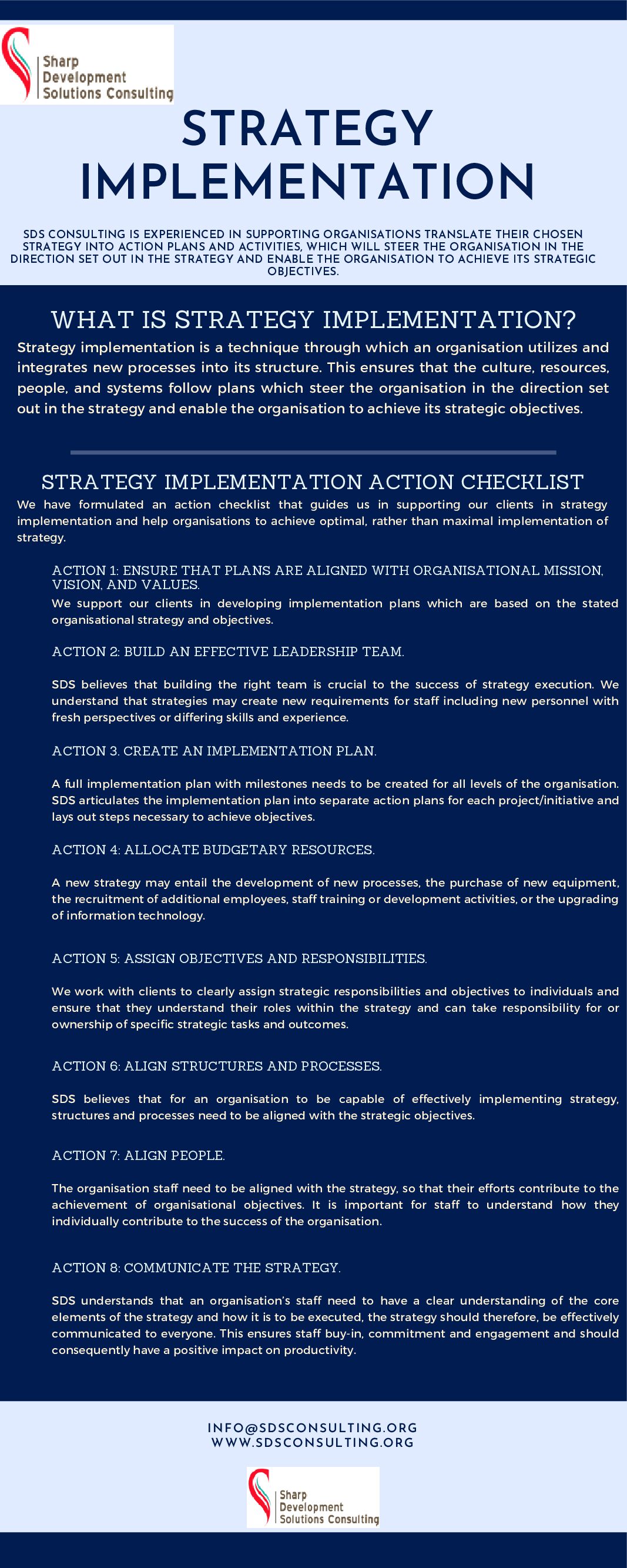A. INTRODUCTION
SDS Consulting is experienced in supporting organisations translate their chosen strategy into action plans and activities, which will steer the organisation in the direction set out in the strategy and enable the organisation to achieve its strategic objectives. We believe that strategic implementation is critical to a company’s success, addressing the who, where, when, and how of reaching the desired goals and objectives.
B. WHAT IS STRATEGY IMPLEMENTATION?
Strategy implementation is a technique through which an organisation utilizes and integrates new processes into its structure. This ensures that the culture, resources, people, and systems follow plans which steer the organisation in the direction set out in the strategy and enable the organisation to achieve its strategic objectives.
C. STRATEGY IMPLEMENTATION ACTION CHECKLIST
We have formulated an action checklist that guides us in supporting our clients in strategy implementation and help organisations to achieve optimal, rather than maximal implementation of strategy.
Action 1: Ensure that plans are aligned with organisational mission, vision, and values.
We support our clients in developing implementation plans which are based on the stated organisational strategy and objectives. We are aware that organisational mission and vision, and values may need to change in response to changing circumstances and should be reviewed regularly.
Action 2: Build an effective leadership team.
SDS believes that building the right team is crucial to the success of strategy execution. We understand that strategies may create new requirements for staff including new personnel with fresh perspectives or differing skills and experience. The implementation of a new strategy may alter priorities, change resource allocations, and involve a shift in relationships. We normalise processes for assessing and developing leadership, by taking an objective view of the existing management team to assess whether the team can implement the strategy.
Action 3. Create an implementation plan.
A full implementation plan with milestones needs to be created for all levels of the organisation. SDS articulates the implementation plan into separate action plans for each project/initiative and lays out steps necessary to achieve objectives. This includes schedules for key activities including resources needed to achieve these objectives. Part of the process also involves quantifying the financial, personnel, operational, time, and technological resources which will be required, as well as identifying those responsible for individual initiatives.
Action 4: Allocate budgetary resources.
A new strategy may entail the development of new processes, the purchase of new equipment, the recruitment of additional employees, staff training or development activities, or the upgrading of information technology. The budgeting process needs to ensure that strategic initiatives are properly resourced and can be implemented in the agreed timescales.
Action 5: Assign objectives and responsibilities.
We work with clients to clearly assign strategic responsibilities and objectives to individuals and ensure that they understand their roles within the strategy and can take responsibility for or ownership of specific strategic tasks and outcomes. It is important for employees at all levels understand how their performance will be measured and evaluated. We create and document metrics for each task and the intended outcomes with expected time frames.
Action 6: Align structures and processes.
SDS believes that for an organisation to be capable of effectively implementing strategy, structures and processes need to be aligned with the strategic objectives. The strategy may be set out in a plan, but organisational structures will determine how it is defined and executed. The activities of different departments need to be coordinated and the skills and capabilities of each unit made available for the benefit of the organisation. This will allow consistency of purpose from the top of the organisation down to operating level as strategy is embedded throughout the organisation.
Action 7: Align people.
The organisation staff need to be aligned with the strategy, so that their efforts contribute to the achievement of organisational objectives. It is important for staff to understand how they individually contribute to the success of the organisation. We advise organisations to consider what skills and capabilities they need to meet their strategic aims, both now and in the future.
Action 8: Communicate the strategy.
SDS understands that an organisation’s staff need to have a clear understanding of the core elements of the strategy and how it is to be executed, the strategy should therefore, be effectively communicated to everyone. This ensures staff buy-in, commitment and engagement and should consequently have a positive impact on productivity. Issues to be considered include messages to be communicated; audience to be reached; behavioural changes needed; communication channels to be used; and measures to evaluate the level of success or failure.
Action 9: Review and report on progress.
We advise our clients to regularly review the strategy implementation process. Strategy reviews allow organisations to track progress, reflect on priorities and identify any issues that may need to be tackled. This includes review meetings which need to be held often enough to keep the implementation process on course.
The regular reporting and reviewing process should be supported by an effective tracking system which can describe and measure performance. Measures such as key performance indicators (KPIs) , can be developed to contribute to achieving specific strategic objectives.
Action 10: Make strategic adjustments, as necessary.
Strategy implementation is a dynamic process which takes place against the background of changing economic, social, and competitive circumstances. Organisations should be flexible enough to make new decisions on the allocation of resources for optimal benefits.
Action 11: Develop an organisational culture that supports the strategy.
Organisational culture plays a significant role in successfully translating strategic plans and initiatives into action. A culture should be aligned to the organisational strategy as a shared belief to promote staff commitment.
Compiled by,
Wanjugu Mathenge,
Project Associate,
SDS Consulting.








